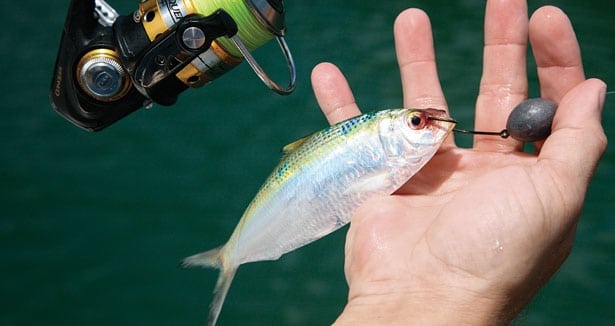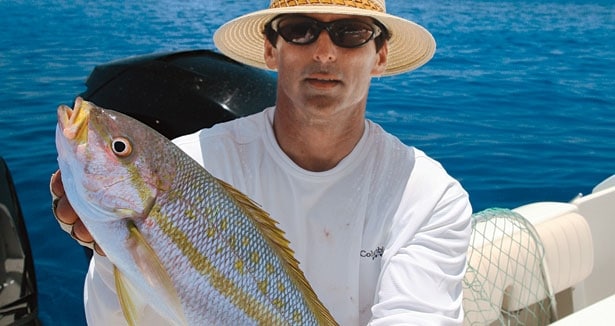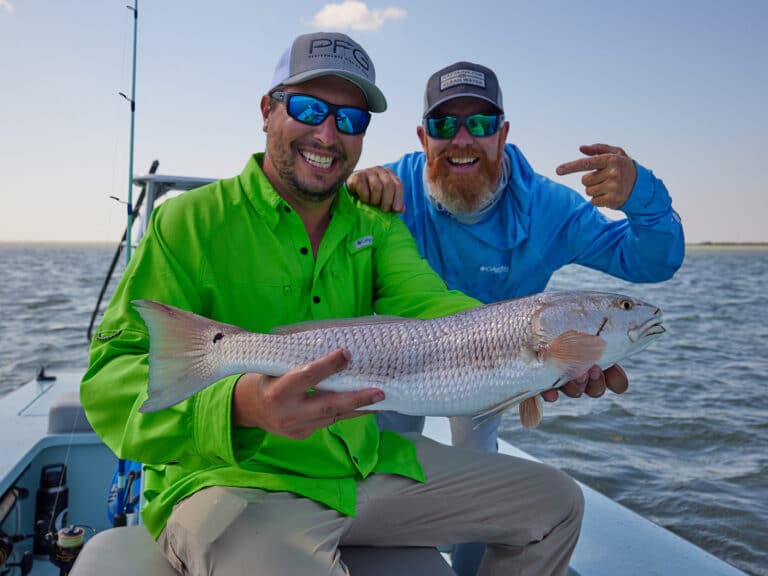
The yellowtail bite was fast and furious, as expected along this Bimini, Bahamas reef. Almost as quick as we’d drift a bait back, we’d pluck a plump yellowtail from the sea. Balls of the golden fish materialized within the water, the more aggressive ‘tails moving to within a few feet of our chum bag. Then, suddenly, they disappeared, as if sucked back into their lairs by some huge vacuum. Predator fish had moved in.
A few large reefs sharks convened deep behind our boat, looking for a snapper struggling on a hook, an easy meal, and the yellowtails wanted no part of that game. Our small silverside-tipped jigs and pieces of bait drifting with the chum had just become obsolete. To continue catching ‘tails, we’d have to bait them on the bottom, and on tackle just heavy enough to crank them up through the water column ahead of the sharks. It was time to change up.
I grabbed two of the larger spinning outfits, both of which were spooled with 30-pound-test braid. I rerigged them with 15 feet of 20-pound-test fluorocarbon leader and a 5/0 in-line circle hook. Before securing the hook to the leader, I added a 2-ounce egg sinker, which rested on the eye of the hook. This is what is known as a knocker rig.
We baited the hooks with pieces of bonito and ballyhoo and dropped the knocker rigs to the bottom. Nearly instantly the snappers consumed the baits, and we rapidly wound them up to the boat, with sharks in hot pursuit. When the score was tallied, we’d won far more of these drag races than the sharks had. But the bottom line was that, once again, the knocker rig paid dividends for us!
Use a Knocker Rig Close to Structure
BottomFishing 101 tells us that using the lightest weight possible to hold a bait on or near bottom while keeping that weight away from the hook is paramount in catching a variety of benthic species. This could range from a hook and sinker separated by just 2 or 3 feet of leader and a swivel for striped bass and snook in inlets or around bridges to a sinker above a 15- to 30-foot-long leader intended to fool mutton snapper. The objective here is to lessen the resistance a fish feels when it picks up, mouths or nibbles at a bait and encourage it to devour that bait and not drop it. This is accomplished through the extra latitude and even slack provided by a long leader coming off of a sinker. The fish takes the bait and feels nothing unnatural until the hook is set and it’s too late.
However, logic does have its limits. And in this case, high-profile and rugged structure — such as ragged reefs, rock piles, wrecks and even kelp gardens — becomes the game-changer. When you’re looking to drop a bait into such dangerous terrain, the knocker rig becomes a worthy ally.
Snapper Fishing with the Knocker Rig
Retired captain Bouncer Smith has long been regarded as the premier inlet, reef and offshore skipper in Florida’s Miami-Dade County. Many believe he has no peer when it comes to catching a wide variety of game fish the likes of snook, tarpon, grouper, snapper, sailfish, kingfish, cobia, dolphin, swordfish and numerous other fish swimming in the local waters. And when it comes to bottom fishing along the reefs and wrecks off southern Florida and Bimini, he gives the knocker rig its share of play.
“The concept of the knocker rig is sort of like dropping into a forest of snagging trees,” says Smith. “The sinker and bait stay together as the rig enters into a heavy-growth reef, so it won’t start off tangled. The sinker stays in place, and the fish can’t tell the difference between the sinker and a rock. With a long leader rig — let’s say 4 feet long — the sinker will land on bottom, while the leader may snag two or three rocks in the process.”
Smith uses the knocker rig to catch just about all snappers and contends it can be used for all sorts of bottom- and near-bottom-dwelling fish that thrive in and around ragged structure. Furthermore, the rig works in conjunction with live or dead baits.

Make Sure Your Knocker Rig Holds Bottom
Contrary to the philosophy of using the lightest weight possible to reach and hold bottom, lighter is not necessarily better with the knocker rig. Smith says the weight should be plenty heavy, enough to remain in solid contact with the bottom. And as simple as this rig appears, there are indeed subtleties involved in getting the most out of it.
“You want to feel the sinker at all times,” says Smith. “Once it’s on bottom, you will reel up just enough to where you feel the weight. You will then actively hold the rod and make certain to feel that sinker at all times. That means you’ll lower the rod when the boat lifts up on a wave, to keep the sinker on bottom, and lift the rod when the boat dips down, to maintain the feel of the sinker on bottom. To make sure the rig is where it’s supposed to be and to sense the slightest activity from any fish playing with the bait, you have to keep enough slack out of the line so you can feel the sinker and keep it in place on the bottom.
“It’s also critical to make sure when tying the line to the hook that the knot doesn’t jam in the sinker, as could happen if the sinker has a large enough hole. If this occurs, it will prevent a fish from running line through the sinker and perhaps enable it to feel the weight and drop the bait. To prevent this, put a plastic bead on the line before tying on the hook. The plastic bead will rest between the sinker and hook eye and prevent jamming.”
Using a Knocker Rig with Suspended Fish
One case in which going with a lighter sinker takes precedence is when you’re baiting fish that are suspending within or adjacent to high-profile debris or structure, such as snapper around rigs and even Pacific yellowtail and kelp bass within kelp gardens. Here a lighter sinker enables the bait to settle a bit slower through the water column and stay where these fish are suspending. In the case of kelp gardens and rig stanchions, a knocker rig will keep the bait and hook together throughout the descent, while a longer leader has the potential to wrap around both sides of the kelp or stanchions.
As mentioned earlier, the knocker rig kept us into the yellowtail snapper action when the predator fish drove them down. Even when the ‘tails are up and close to the boat, we often pitch a knocker rig well back into the slick, where it falls to the bottom behind most of the activity. And quite often, we pick off our largest ‘tails that way. Just recently we spent a day on a different Bimini reef, dropping live pilchards on knocker rigs; we scored amberjack to 40 pounds, horse-eye jacks to 15 pounds and, of course, yellowtail snapper. The setup is excellent on mangrove snapper on the reefs and rock piles, and we’ve scored cobia and goliath grouper on the knocker rigs when fishing over wrecks.
In-line, non-stainless-steel circle hooks make effective knocker rigs, and they’re required by law when bottomfishing in the Gulf of Mexico. I prefer using an overhand loop knot to join my circle hook to the leader, believing that the loop gives a live bait pinned to the knocker-rig hook more freedom to swim. And when the bite’s slow, I believe that extra bit of freedom prompts more strikes. What’s more, a properly lodged circle hook will remain intact, while a J-style hook becomes more susceptible to being thrown with that sinker riding so close.
Newcomers to the knocker rig often wonder why a fish wouldn’t notice a lead sitting right on top of the hook and shy away from the rig. My answer to that question is that game fish strike deep jigs and even jigs tipped with bait — so why would the knocker rig look much different, save for the lack of a fancy coat of paint?
The next time you find yourself wanting to cull bottom-fish from tough terrain, don’t out-think yourself by dropping down fancy leaders and rigs, which just might tangle or snag. Give the knocker rig some soak time. It’s certainly not much appearance-wise, but it has been catching bottomfish for decades, making many a marginal angler look like a rock star back at the dock.
George Poveromo’s Knocker Rig Tackle Setup
- Reels: Penn Conquer 4000, 5000 or 7000 spinning reel, or equivalent.
- Rods: Penn Torque spin model TJ2050S70 (20- to 50-pound rating).
- Line: 20- to 30-pound braid.
- Leader: 15 feet of 20-pound fluorocarbon.
- Hooks: VMC In-Line Tournament Circle (model 7385), size 5/0 or equivalent.
- Chum: Capt. Mark’s Pure Sardine Chum or a similar concoction.









